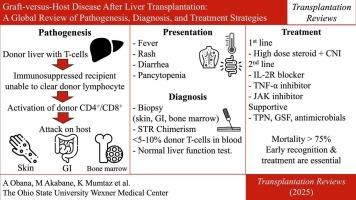肝移植后移植物抗宿主病:发病机制、诊断和治疗策略的全球综述
IF 3.6
2区 医学
Q2 IMMUNOLOGY
引用次数: 0
摘要
肝移植(LT)后移植物抗宿主病(GVHD-LT)是一种罕见但高度致命的并发症,发生率为0.1% - 2%,死亡率超过75%。当移植到同种异体肝内的供体来源淋巴细胞将受体组织识别为外来组织并发起免疫攻击时,GVHD-LT就会发生,主要针对皮肤、胃肠道和骨髓,同时保留供体肝移植物本身。本综述综合了目前关于GVHD-LT发病机制、临床表现、诊断方法和治疗策略的知识,基于对1988年至2025年报告病例的系统文献分析。临床表现通常发生在移植后2-12周,伴有发热、黄斑丘疹、大量腹泻和进行性全血细胞减少症。诊断依赖于组织活检显示特征性的组织病理学变化,并结合分子嵌合分析证实供体淋巴细胞的持久性。风险因素包括受赠者年龄;50年来,肝细胞癌作为潜在疾病,和特异性供体-受体免疫不匹配。由于加强免疫抑制以控制供体淋巴细胞活性和防止压倒性感染之间需要微妙的平衡,管理仍然具有挑战性。传统的大剂量皮质类固醇治疗效果不佳,包括JAK抑制剂、体外光诱导和靶向细胞因子阻断在内的新兴治疗方法在类固醇难治性病例中显示出希望。高炎症状态经常与噬血细胞性淋巴组织细胞增多症重叠,需要专门的治疗方法。尽管治疗取得了进步,但预后仍然很差,机会性感染引起的败血症是导致死亡的主要原因。未来的方向强调迫切需要风险分层模型、预防策略和多机构合作试验来改善这种破坏性移植后并发症的结果。本文章由计算机程序翻译,如有差异,请以英文原文为准。

Graft-versus-host disease after liver transplantation: A global review of pathogenesis, diagnosis, and treatment strategies
Graft-versus-host disease (GVHD) following liver transplantation (LT) (GVHD-LT) is a rare but highly lethal complication, occurring in 0.1–2 % of recipients with mortality rates exceeding 75 %. GVHD-LT develops when donor-derived lymphocytes transferred within the hepatic allograft recognize recipient tissues as foreign and mount an immune attack, primarily targeting the skin, gastrointestinal tract, and bone marrow while characteristically sparing the donor liver graft itself. This comprehensive review synthesizes current knowledge of GVHD-LT pathogenesis, clinical manifestations, diagnostic approaches, and therapeutic strategies based on systematic literature analysis of cases reported from 1988 to 2025. Clinical presentation typically occurs 2–12 weeks post-transplant with the classic triad of fever, maculopapular rash, profuse diarrhea, and progressive pancytopenia. Diagnosis relies on tissue biopsy demonstrating characteristic histopathological changes combined with molecular chimerism analysis confirming donor lymphocyte persistence. Risk factors include recipient age > 50 years, hepatocellular carcinoma as underlying disease, and specific donor-recipient immunologic mismatches. Management remains challenging due to the delicate balance required between intensifying immunosuppression to control donor lymphocyte activity while preventing overwhelming infection. Conventional high-dose corticosteroids yield poor outcomes, with emerging therapies including JAK inhibitors, extracorporeal photopheresis, and targeted cytokine blockade showing promise in steroid-refractory cases. The hyperinflammatory state frequently overlaps with hemophagocytic lymphohistiocytosis, requiring specialized therapeutic approaches. Despite therapeutic advances, prognosis remains poor, with sepsis from opportunistic infections representing the leading cause of death. Future directions emphasize the urgent need for risk stratification models, preventive strategies, and multi-institutional collaborative trials to improve outcomes for this devastating post-transplant complication.
求助全文
通过发布文献求助,成功后即可免费获取论文全文。
去求助
来源期刊

Transplantation Reviews
IMMUNOLOGY-TRANSPLANTATION
CiteScore
7.50
自引率
2.50%
发文量
40
审稿时长
29 days
期刊介绍:
Transplantation Reviews contains state-of-the-art review articles on both clinical and experimental transplantation. The journal features invited articles by authorities in immunology, transplantation medicine and surgery.
 求助内容:
求助内容: 应助结果提醒方式:
应助结果提醒方式:


